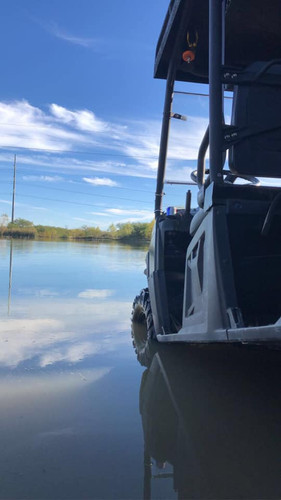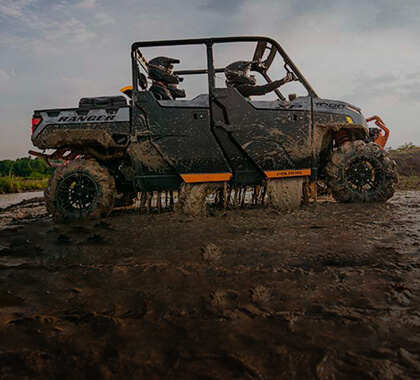A Detailed Understanding Of Polaris Ranger Turf Mode Issues
Dec 29th 2019

If you go around researching Polaris Ranger turf mode issues, you’ll likely end up more confused than you started. Many people you’ll talk to might say that the newer Polaris Rangers don’t have the same turf mode issues as the older ones. Others might say that Polaris Ranger turf mode issues are a myth, and damaged causes while in turf mode is due to improper driving. We here at Everything Polaris Ranger, however, realize that this is a nuanced issue. We know folks who’ve run thousands of miles on jacked up Polaris Rangers with monster tires, lift kits, and other performance accessories who've experienced zero issues with their machine’s turf mode. We also know riders who have suffered from Polaris Ranger turf mode issues on stock machines with low triple-digit milage while doing simple things like loading and unloading from flatbed trailers and enclosed toy haulers. So what’s the deal? Is there a problem with the turf mode on the Polaris Ranger? And if so, what can one do to mitigate the risk of damage?
The obvious truth of the powersports world is that if you go out and beat the crap out of your machine, things are bound to break. We know certified Polaris mechanics with over 10K miles on their Rangers that have never had the slightest issue with their rig's turf mode. On the other hand, we also know people with barely-used trailer princesses that have gotten a taste of Polaris Ranger turf mode issues. What gives?
Exacerbating Polaris Ranger Turf Mode Issues
Now if you jack your Polaris Ranger way up and put tractor tires on it, there will undoubtedly be added stress on the vehicle and its constituent components. This extra stress factors will then increases the likelihood of damage. You’ll frequently hear people bashing the Polaris Ranger reverse chain and turf mode setting. But if you think about it, Polaris has been in business for ages, and If they didn’t make a high quality machine, they would surely be out of business by now. So yes, the turf mode is an issue, but you can’t discount operator-induced damage.

User-Caused Polaris Ranger Turf Mode Issues
A fair number of Polaris Ranger turf mode issues can be attributed to operator error — whereby a driver engages turf mode while moving or when the side-by-side's tires are still spinning spinning. Even if you’re not deliberately engaging your Polaris Ranger transmission while the tires are in motion, it is possible for the solenoid to have a bad connection and lock or unlock of its on volition own, causing the gear teeth to bind, grind, or break off completely.
That as well as overloading the spool on modified side-by-sides are the two primary reasons why Polaris Ranger turf mode issues occur. Yes there are cases where the bolts holding the turf mode components together backed out, but the only way this can occur is through excessive amounts of vibration. It does happen, sure, but not to the extent that some would like to portray.
Fixing Polaris Ranger Turf Mode Issues
This issue of bolts backing out and busting the transmission case is the typical culprit for turf mode issues in older Polaris Ranger models. To prevent this, you must take the transmission apart and glue the turf bolts in place with Loctite to prevent them from unscrewing and falling out. Alternatively, you can delete the turf gear and spool all together, or install a better spool like the ones used in the Polaris RZR.
Although the issue is less prevalent in newer editions of the Polaris Ranger, it can still occur. Cheap components and design flaws can cause teeth to break in the turf gear of newer Rangers. These broken gear teeth then fall off, bind things up, and cause the transmission case to break.

If you go online, almost all of the posts you’ll see with regards to Polaris Ranger turf mode issues involve people with huge lift kits and other aftermarket modifications, which might lead you to believe that those with stock Rangers experience no turf mode problems. A long-time customer of ours used to think the same thing. His Ranger was completely stock, and the turf mode exploded out of nowhere. Luckily for him, the transmission case didn’t break, and he heard it popping and brought it straight to the shop before serious damage occurred. Although this story is anecdotal, it has been corroborated by countless other Polaris Ranger riders with similar experiences.
The taller and heavier your tires get, the more likely it becomes that your turf mode will explode. Bigger tires put more stress on the rear axle, and this stress adds both friction and heat. So even if you put Loctite on your turf mode bolts, heat can cause the adhesive properties of Loctite to break down. So bigger tires can be the indirect cause of Polaris Ranger turf mode issues due to the extra exertion of force they place on the machine as a whole and the turf mode bolts in particular.

The post 2019 editions of the Polaris Ranger have improved turf mode, but it’s still not bulletproof. You can jump your Ranger, roll it over a few times, and break multiple front differentials without breaking the turf mode components. That being said, it’s cheaper to fix your Polaris Ranger turf mode issues before they result in bigger problems down the line. And if you’re running a lifted machine with heavy tires, your chances of busting your turf mode only increase.
Pre- And Post-Damage Polaris Ranger Turf Mode Solutions
If you’ve busted your transmission case due to Polaris Ranger turf mode issues, you’re going to need a replacement case. You should also consider getting a double reverse chain upgrade, a heavy duty pinion plate, and the turf delete (spool). If you don’t ride at high rates of speed, you might also want to consider a Polaris Ranger gear reduction.

For those who want to delete their Polaris Ranger turf mode themselves, the turf mode comes out relatively easily in one piece, and the spool goes right back in the exact same spot. It’s pretty simple if the damage has yet to occur, but getting to a split case can be a bit of a hassle. No matter if you have the Polaris Ranger 570, the Ranger 800, or a 1000cc Polaris Ranger, just take your time and try to remember where all the pieces go. You can also take pictures with your phone as you go so that you don't forget anything when the time comes to put everything back together. Once you pull the case apart, you can pull out the turf gear and drop the replacement in. There is a retainer that holds the turf mode in — mounted using four Allen head bolts. You should be able to wiggle it out by itself.
Closing Thoughts On Polaris Ranger Turf Mode Issues
When it comes to turf mode, it's all about reverse. Although mechanical failures associated with turf mode can, in some cases, be attributable to changes in vehicle geometry involving suspension lifting and larger-than-spec tire size, you should always remember to never abuse reverse... not even a little bit. This is because the rear chain is not designed or built tough enough to take any kind of reverse abuse. So use your machine's turf mode in high traction environments, but don't beat your machine like a rented mule and expect it to remain in perfect working order for extended periods of time. Removing the reverse chain in your Polaris Ranger and replacing it with a gear-style reverse will help, and you can always add heavy-duty cases and bearings to your UTV as well. The options are out there, now it is up to you to make some decisions about what to do regarding the turf mode in your Polaris Ranger!



